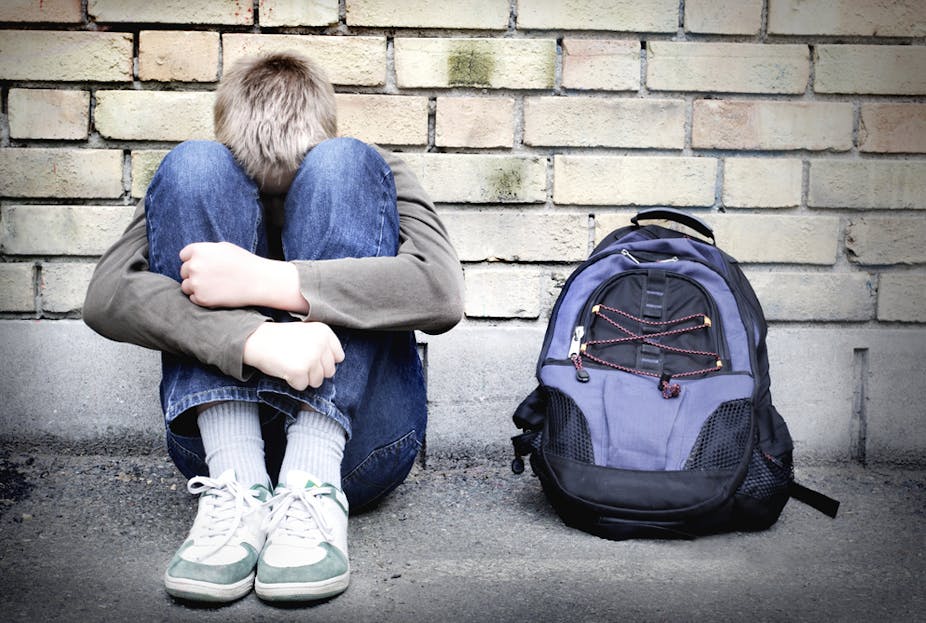There has been a series of disturbing homophobic bullying incidents in Queensland schools in recent months.
Some of the cases reported in the media included a Brisbane student being allegedly told by male teachers she would burn in hell, and a boy having excrement wiped on his bag by students who believed he was gay.
Unlike in many other states, the Queensland government’s education policies and training programs have no explicit consideration of homophobic bullying or its prevention.
In addition, teachers are given no specific training on the issues of homophobic bullying which research shows has significantly increased over the past decade.
Only Queensland’s Inclusive Education Statement lists an appreciation of “sexuality” within indicators of inclusive education. But this is the only Queensland policy document that comes close to dealing with gay, lesbian, bisexual, transgender or intersex (GLBTIQ) students in any sense at all. And just the one mention of “sexuality” – a vague term which could be interpreted to just mean “sexually active students” or “pregnant students” – clearly falls short of the standards set in other states.
One such example is Victoria’s eight page Supporting Sexual Diversity in Schools policy and detailed guidelines on students with a transgender or intersex status.
Unfortunately, research shows Queensland teachers generally only understand the Inclusive Education Statement and its related resources as relevant to students with disabilities.
My PhD research uncovered that Queensland GLBTIQ students were the most likely of all students (across all states and territories) to say their school did not provide sexuality education, and did not provide any relevant sexuality education around GLBTIQ topics.
Over one tenth of Queensland GLBTIQ students received no sexuality education at all throughout their entire schooling, and this rose to 23% of students in Queensland Catholic schools.
Only 13% of Queensland students were taught that homophobia is wrong – far fewer than in Victorian or NSW schools.
Oddly enough, there have actually been some incredibly promising curricula module topics in Queensland’s older Health and Physical Education syllabus covering same-sex attraction and gender identity. But the study of the modules is not mandated and teachers haven’t received adequate training on the diversity content in order to cover them, unlike in NSW schools for example.
A further issue is the misconception that tackling bullying “in general” is the same as tackling homophobic bullying specifically. Queensland Education Minister John-Paul Langbroek has voiced his opposition to bullying in any form, calling it “unacceptable”. He sees Queensland as leading the rest of Australia in the fight against school bullying because it has “more than twice the number of students taking part in the National Day of Action Against Bullying than any other state or territory”.
His passion for tackling bullying is certainly commendable. But we must remember that there are school staff and students who simply do not consider homophobic violence or verbal abuse as bullying.
These are turbulent times in Australia wherein moral perspectives on gay marriage and gender norms are under heated and constant debate in the media, and some politicians and religious groups think little of making extremely homophobic statements – presenting poor examples for school staff and students who might parrot these perspectives in the classroom.
So Queensland schools are falling short. This is due to a lack of explicit anti-homophobia policies, a very limited model of “inclusive education”, a lack of mandated sexuality education and teacher training, and too broad an approach to bullying which does little to impact systematic and institutional homophobia.
It is essential for the Queensland education department to remind staff in no uncertain terms that regardless of their personal opinions or private moral values, they have responsibilities under international human rights treaties to provide education and training to “prevent discrimination and stigmatisation of LGBT and intersex people”.
They also have legal and professional duties not to discriminate and to ensure that the school environment is a safe and supportive space for their GLBTIQ students; indeed, for any student who may be subjected to homophobia regardless of their sexual orientation.
Only once this is recognised, can the Queensland education system be in the best position to tackle homophobic bullying head on.

